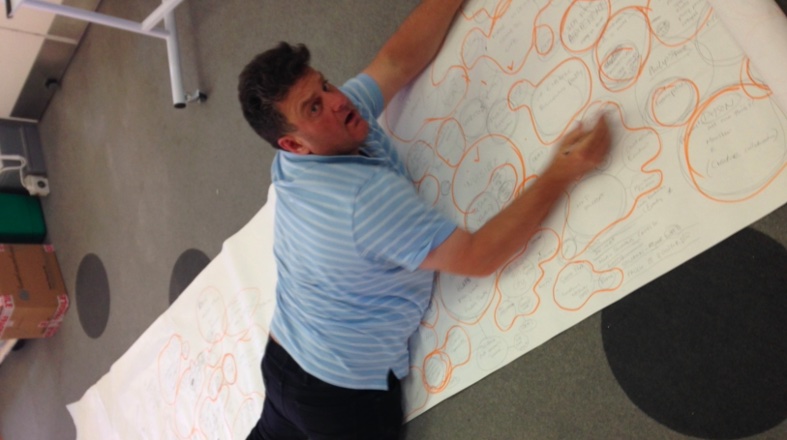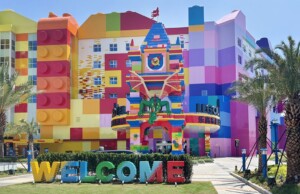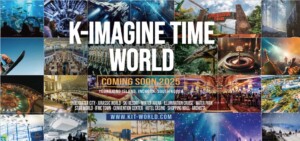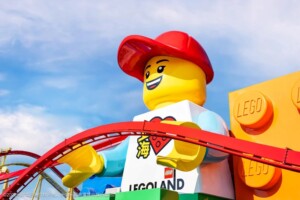Merlin Entertainments has redefined the visitor attractions landscape over the last two decades, with its rapid strategic growth taking it from a £7 million EBITDA to a £569 million business with 140 attractions worldwide. Merlin’s R&D department is its creative crucible, driving forward innovation and finding new ways to delight, thrill and entertain its millions of guests who visit every year.
Merlin R&D is now embarking on a new phase, reaching out to innovators to collaborate on the next generation of visitor experiences for the post-pandemic world.
“I think we tend to keep Merlin Magic Making hidden under a bushel. The big message is that now everybody’s invited to the Merlin party.”
Justin East, Merlin Entertainments
Blooloop spoke to Justin East, global senior creative director, research and development at Merlin Entertainments, and Jeff Parker, research and development creative lead at Merlin Magic Making, Merlin’s creative production arm of the business, about just what this means.
So, what does Merlin R&D do?
People will be aware of Merlin Magic Making, but what is the role of Merlin R&D?
“What we do is provide a pipeline of new products to the business, and incubate them until they are ready to be prototyped,” East explains.
“Every time the business wants a new ride, a new Midway [a part-day visit attraction, often in key gateway cities] or a new theme park, we ensure they have a huge amount of choices to select from. We ensure there are so many brilliant ideas and options on the table they have a difficult choice to select one
“We work within the existing businesses to cross-fertilise with the creative directors on all the brands: LEGOLAND, the Resort Theme Parks, LEGOLAND Discovery Centres, Madame Tussauds, and SEA LIFE. The nuts and bolts of it are that we nurture the project until it gets approved by the Merlin board, and then another team take it over to develop and deliver the concept.”
Asking what’s new
East continues:
“Our job is to go out there, eulogising Merlin and the creative department, like a prophet; asking partners – all the ride manufacturers, the technology providers, the immersive theatre providers, the immersive dining, all the theme parks – what’s new?

“We make connections to develop and create our own products, sometimes with existing or new intellectual properties.”
Merlin is a large organisation, but this department, because it’s such a small group in comparison, can be more agile:
“We have a certain entrepreneurial freedom and are able to orbit from the rest of the business.”
He gives an example:
“I rang up Derren Brown and said, do you want to do a ghost train? He said, ‘Yes.’ And we went on to develop one with his incredible showmanship skills at Thorpe Park.”
The Concept Lab – disruptors
The R&D team comes up with the ideas, conceptualises them, and creates visuals to bring our ideas to life.
“We’ve got a concept lab where we mock-up the visual that you might see at the underground, or you might see in your local town centre, we mock those up to trial the idea before we even start the whole process, to see if the product can be communicated easily.”
“It’s fun, but it’s also a sanity check,” Parker says. “It means that if we can’t communicate what the proposition is with one punchy strapline and title, and make it look like something people will really want to do, then it will be hard to market at any stage, and needs re-thinking.”
East agrees, adding:
“We have a quarterly creative review with Nick Varney, the CEO, so we need to be able to have that simplicity of communication to sell the concept.
“It takes a lot of work to get it razor-sharp, so you can sell the whole idea of what the proposition is from a marketing point of view, and what the delivery mechanism is from a technology point of view. When you get those combined together, it becomes better than the sum of its parts.”
The creative process

“At the point where we’re coming up with the initial concept,” Parker explains, “We’re not tied by budget or any restraints; that all comes later!
“If we are involved in the design process, it is at that stage that reality kicks in, when we’re talking to manufacturers, and so on. But what we prefer to do is hand that process onto somebody else, who can own the production. We like to come up with the initial idea, the concept, and the creative big thing.”
East adds:
“We also have a slightly rebellious remit, in that we can work separately from the business, where we can challenge and be disruptive to the business on the quality of ideas, if we think ideas are ‘vanilla’, or just not strong enough, we have a broad scope to challenge it. It’s what makes it such an interesting job.”
True innovation is rare
Merlin R&D are often pitched new concepts and ideas. However, true innovation is rare.
Parker says, “It’s not reinventing the wheel, but at the same time when we are talking to people about potential new ideas and concepts, obviously, to a degree, people are very protective of their ideas.
“Sometimes, someone will come to us with an idea that they’re being very protective about, and, when we look at it, it’s something that has been thought of a million times in a million different ways. We can show them the posters we did 10 years ago.”
Innovation, he explains, often develops best in an atmosphere of collaboration:
“We work with the Madame Tussauds teams on prosthetics and robotics, which I always find really fascinating.”
East says: “We went through a whole development cycle about robotics. We’ve got mask technology, for instance, where a live actor can wear the mask of a celebrity.”
Simple solutions
The mask came about as a moment of inspiration when considering developing robotic celebrities:
“I was thinking, ‘God, this is so expensive and painful. Why don’t we just put somebody in a mask and pretend they’re a robot?’ That worked really well. We had them on Britain’s Got Talent: Harry and Meghan.”
“When we want to jump onto a current celebrity story you need to be able to act quickly. A complex robot is a challenging technology to develop quickly.”
Often companies have a great product but need to be open to adapting it for Merlin’s particular requirement. Parker gives an example:
“We also work with Millennium FX, a production company which provided the prosthetics for Doctor Who, Torchwood, SJA and Class.
“They do a lot of Hollywood stuff. Working together has been a learning curve on both sides. They can make a fantastic looking monster for a film that’s only on screen for 20 minutes, but our challenge is that we need something that will be in a park being manhandled by adults and kids, potentially. This means different materials, and looking at how they can make it better and stronger.”
Merlin Ventures
The R&D team also has a wing called Merlin Ventures under its auspices.
East explains its function:
“For example, for a two-year period, Jeff and I were going out, looking at all the businesses that were bringing fresh ideas and experiences to the market that we didn’t know anything about, like immersive theatre, immersive dining, selfie palaces, immersive escape rooms, art installations, virtual reality and augmented reality experiences.”
The idea was to come to an understanding of these businesses, with a view to acquiring or developing our own.
“We don’t really get any marketing briefs. We come up with ideas, working with our group creative director. So, we create idea banks. Then, when a brief comes in, we match an idea, technology and proposition with the brief.”
There is a clear parallel with the Disney Imagineer process.
Merlin R&D explores key trends: kidulting

One example of the objectives for this year, East explains, is to create the most innovative experience ever seen in a dungeon. Another focus is out-of-hours projects or products.
“At the moment, the majority of our stuff is open nine to six. Obviously, millennials and Gen Z want to go out and spend their money after six o’clock. Therefore, we are looking at ways to realign in that market, by reimagining the existing estate, either with external partners or by ourselves.”
Kidulting is a big trend:
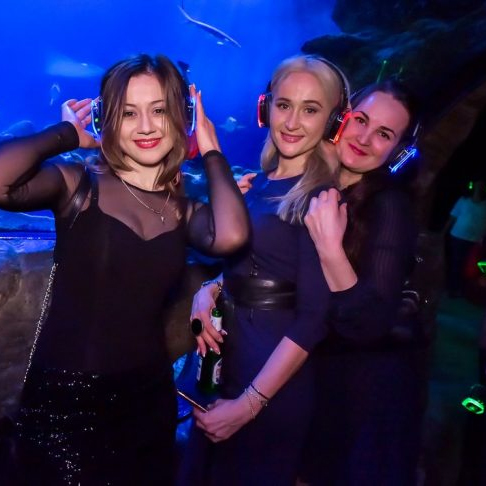
“Millennials have disposable income for experiences and doing things. They’re less obsessed than previous generations with drinking. So, it’s more about creating safe environments for exciting things for people to do. The kid element of it is that nostalgia is a huge trend.”
“LEGO is primarily, obviously, very much aimed at kids and young teenagers. However, there’s a huge swathe of adults that do it, too. A lot of it again has to do with nostalgia. Tapping into that involves finding the ways in which LEGO is a lifestyle product for everyone. What do you do with a park or LEGO Discovery Centre after hours?
“How do you make it more appealing to that whole demographic? Darts, golf, giant climbing and treetop experiences – all sorts of things are being reimagined.”
Part of that is an awareness that people are more discerning now. When they go out to do an activity, they’re not happy with just having a burger and chips and a beer anymore; they want cocktails, good quality F&B and a 360 experience.
New technologies: multimedia experiences
Multimedia has revolutionised attractions, and there is much talk of the metaverse doing the same. Offering an example of how multimedia can be used in an interesting way, Parker says:
“The War of the Worlds experience brought together live actors, AR, AI, physical props, and physical effects. It was a really clever amalgam of pretty much everything that we look to use.”
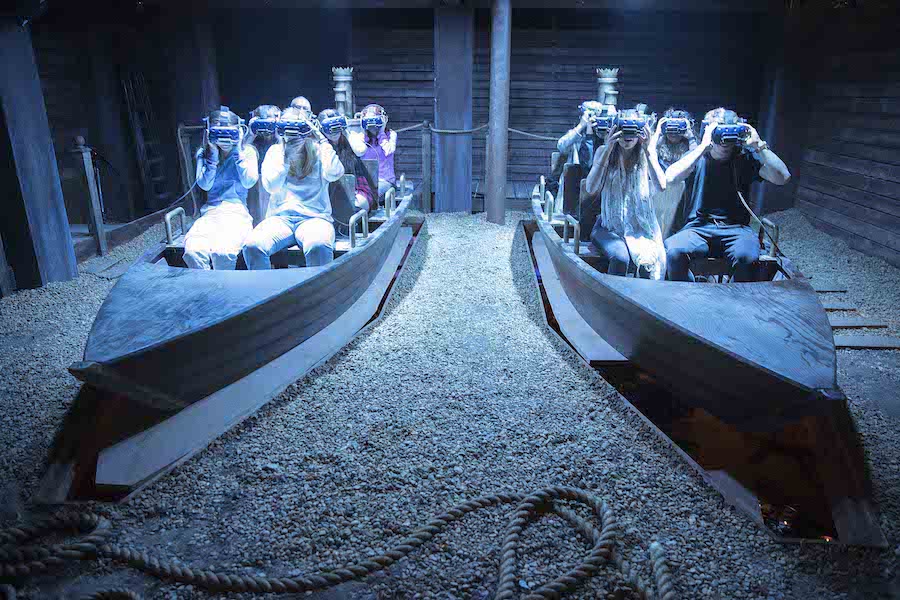
East agrees:
“It allowed you, in a room of about five meters by five meters, to experience something on the epic scale of a Cecil B. de Mille film, going down the Thames using virtual reality. It is a clever use of VR. At one point, virtual reality was being put on everything, as a marketing novelty. At the moment, of course, the metaverse is the current buzzword.”
The metaverse
Parker adds:
“It is, at present, just that: very much a buzzword; nobody really knows what it is, though people are investing huge amounts of money in it.
“I can understand Disney wanting to be at the forefront. They’ve got so many platforms with their home entertainment, films, and cinema. They own half the IPs on the planet. So, they will want to be careful about how they police the metaverse, or what it becomes. But I think it’s like the early days of the internet and the dot-com bubble.”

Caused by massive speculation during the early period of huge growth and adoption during the early days of the Internet, the dot-com bubble, when it burst, people lost fortunes.
“I think it will be the same with the metaverse,” Parker says. “Until people start using it and understanding it, it evolves. Then people will know where they should be investing money.”
For the present, East says:
“If I were putting my money anywhere, it would be on Merlin being the largest player in Europe where you could have an extension of your brand in a three-dimensional, visceral experience. We should be playing to our strengths, though, of course, we should also look at the metaverse.”
Developing new formats at Merlin R&D
Another key development area for the team is looking at new formats.
East says: “At the moment, when we roll out a product, we have a new high-value ride, typically, in a park, like LEGOLAND or such as The Wicker Man at Alton Towers Resort, or Derren Brown’s Ghost train at Thorpe Park Resort. Then we might have a second gate; if we are growing something into a resort destination, we need more product there to warrant the guests staying there and wanting to return.”

“I worked on a LEGOLAND water park about 14 years ago. Now, it might be right for those to stand alone instead of being in a destination resort. But the holy grail is to get a product that you can roll out in 35 destinations around the world. The tendrils of LEGO the brand go out into the world and exalt the values of the brand.”
Parker explains:
“We are generating ideas every day. It’s like throwing stuff at the wall: only a certain amount of it sticks. However, we’re constantly building these ideas, which are never really thrown away; they’re all ripe for recycling. It might be that something wasn’t right for LEGO. But it could be that this idea is the germ of something that would be excellent for Dungeons, for example.
“When we look at a brief on a product, we might look at it, like it, and develop it, but it’s not quite the right fit. Six months later we might think, hang on, this really works well.”
Tenacity & simple ideas
East gives an example:

“When I was doing this job for LEGO, there was a concept [then] called the Fire Truck Challenge, where the whole family participated in a physical challenge to put out a fire. It is a very simple technology. I must have pushed that idea for eight years uphill. Everybody kept saying, ‘Oh, don’t go on about the Fire Truck Challenge again.’ I just kept going, and then eventually we did it. Now it’s in all the parks.”
Fire Academy is a unique ride that has become a LEGOLAND classic. It allows families to race against each other in their own fire engines, aiming their fire hoses at a burning building to put out the flames.
“There’s a lot to be said for tenacity, and for not letting people tell you that an idea is not good. There is also a lot to be said for not being afraid of a simple idea. And more money doesn’t always mean better!”
Future developments at Merlin R&D
Touching on the strategy in terms of future development, Parker says:
“From an R&D perspective, Merlin’s constant strategy is looking at what’s happening in the world. We are looking at trends, looking at new products, looking at new forms of entertainment. There are things that people are doing today that, 10 years ago, weren’t available.”

The department is responsible for developing an R&D global network to provide insight and unconventional thinking toward the creation of disruptive entertainment products.
East says:
“We’re responsible for identifying businesses to buy, developing new products, and incubating them for deployment across the world.”
“Our big focus is on new product development for LEGOLAND, which is a big brand for us. We do blue-sky thinking for Chessington World of Adventures, Alton Towers, Heide Park, Thorpe Park, Warwick Castle and Gardaland, and for LEGOLAND too. We do a lot for Madame Tussauds, SEA LIFE, LEGOLAND Discovery Centre and the Dungeons.
“That’s our day-to-day work in terms of looking after the business. Then our strategy is looking forward to identify trends and new products that we can formulate into formats such as Midway, the new theme park immersive experiences; we find the propositions, and then put them into formats.”
Different kinds of innovation
East gives an example:
“In 2012, I came up with the idea of putting a LEGO submarine through a SEA LIFE aquarium. I wanted to introduce children to the sea in a really cool way and help educate them about conservation. They could get in their own submarine and go through the aquarium. That’s one of the products we suggested that year. Another was the LEGO haunted house. One was a dinosaur concept.”
“Our absolute holy grail,” he says, “is inventing something that, at the moment, we don’t know we need.
“There are different kinds of innovation. There is the dramatic game-changer: the propeller to the jet engine is that type. Then there’s incremental innovation, which is adding water to dark rides, or the ability to have a trackless dark ride. To develop something, we don’t yet know we need, though, would be the ultimate goal.”
Our absolute holy grail, is inventing something that, at the moment, we don’t know we need.
Justin East, Merlin Entertainments
Inspiring attractions
For instance:
“I went to Meow Wolf and was blown away,” says East. “It was just incredible. And then, possibly the best thing I’ve ever seen in my life is the Machines de l’Ile.”
An artistic and cultural tourism project, the Machines de l’Ile is a fusion of the invented worlds of Jules Verne, the mechanical universe of Leonardo da Vinci, and the industrial history of Nantes. The attraction is located on an exceptional site in the former shipyards. It includes a 12-meter tall quasi-robotic steampunk Great Elephant, which can carry 60 people, a carousel of marine creatures, and a gallery that showcases a bestiary of machines.
Parker agrees:
“We get a bit jaded. But, as Justin said, it’s one of the few times I’ve seen something so completely inspiring. I was awestruck.”
The future strategy involves focusing on big brands, such as Madame Tussauds and LEGOLAND while continuing to create a pipeline of products to fulfil the price points of what Merlin will be rolling out over the next few years.
Reaching out to new talent
Like everyone else, Merlin R&D experienced some constraints over lockdown. The division was unable to bring in interns, hold creative jams or meet with suppliers.
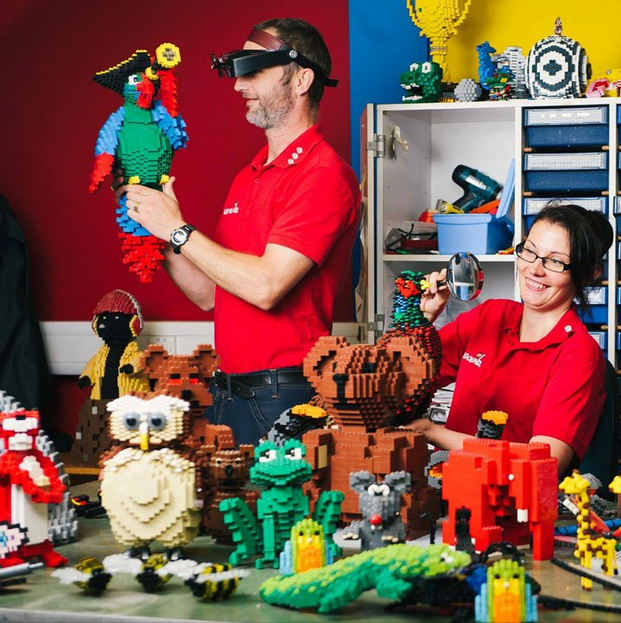
However, COVID has also introduced new ways of working and made it easier to collaborate remotely across continents. Ever the innovators, East and Parker are keen to move forward with exciting new programmes. They want to work with students, creatives and companies to create the next generation of visitor experiences.
“The elements of our three-pronged attack comprise attracting brand-new talent, creative people, and innovative companies from the industry to work with,” says East.
A key objective of the programme is to reach beyond Merlin’s traditional recruitment base.
“Traditionally, they would be from an art and design background, but I no longer believe we should be constrained by that.
“We’re looking for people who are uninhibited by their thought processes. When I worked with LEGO, we did lots of projects with primary schools. I saw some of the most fantastic responses to a brief that I’ve ever seen in my life. They were completely unconstrained!”
Student internships

Merlin R&D is kicking off with a summer internship.
East says, “I think the interest in the job is you get a breadth of everything. We might be developing a new intellectual property for Merlin. We might be mentoring. I’ve been the group creative director of LEGO, of LEGOLAND in Merlin. Nowadays, I’m 56, and I’m getting excited about the idea of mentoring people who are coming through the business.”
“For a graduate, an engineer, a sculptor, an artist, a graphic designer, an architect, an industrial designer, this is a great place to work. We are planning to do a whole ‘day in the life of’ series for social media. Just to let people know that we’re here.”
Creative Network for ingenious individuals
“I’m also very keen on having people with an interesting perspective in on a freelance basis to keep us fresh,” says East.
The team is putting out a call to arms to the imaginative – jugglers, designers, magicians, actors, comedians, and more – to come and talk about products on a regular periodic round-table basis.
“We’re looking for people who are uninhibited by their thought processes.
Justin East, Merlin Entertainments
Parker says:
“Part of our mandate is also brokering new relationships with external people; finding people of talent that are doing creative things, making an introduction with them, then seeing, from the first point of contact, what we could potentially collaborate on with Merlin R&D.”
“Depending on where that goes, we might then introduce the individuals to the company to see if there’s any potential of opening up something that they’re doing externally.
“Before lockdown, we were quite proactive. We would have young students in to keep us fresh, then we had a whole load of disparate creatives. For instance, comedians, circus performers, and magicians.
“We used to have what we called ‘rocket sessions’. We would design a brief, and ask people to come along with a concise pitch of one paragraph, so they didn’t bore us with pages of technical stuff: it’s not about technology. Technology is just one strand of the argument. It’s about entertainment.
“We ran the sessions for five years – sans alcohol – in a pub down the road. Once people got relaxed with the format, we had some really good, stimulating debates. There would be tech guys there from Wired magazine versus a stage magician, who thought everything had to be visceral.”
Erratic, chaotic brains
“Quite often, the people who really get it are those with erratic, chaotic brains rather than granular, analytical ones,” he continues.
“Going back to the way kids think, we tend to get obsessed with narrative and a story. And while story is important, sometimes the abstract, surreal thoughts children have that, as an adult, you can’t get your head around, make you think, ‘Why is this happening? What’s going on?’ – and show that, to a degree, it doesn’t matter. Is it fun, is somebody laughing? Is it good? Then, great.”
The pair envisage that the new online Creative Network sessions will be, initially, quarterly events. However, they may become monthly if the format proves successful.
“We don’t know at the moment, how popular this is going to be,” Parker says. “Are we going to be inundated with talent, or will it be a trickle of people? If the floodgates open, there might be a full-time job for somebody categorising, archiving, and making sure we keep on top of it.”
East agrees;
“It may get a bit unwieldy, but I’m thinking it’ll be like having a football team. You might have some really good ones that really take to it. Then you have people on the bench who are waiting to come in. We might find that there are different dynamics that work well within the group. We might split them into groups of four for periods, and say, go away and think about this.”
Innovation Pitch events for companies
The third strand of the programme is to reach out to innovative companies. Blooloop is working with Merlin R&D to create Innovation Pitch events. The first one on 6 July will explore the future of dark rides.

East says:
“We’re going to establish a platform where people in the Blooloop community who have rides or exciting products can have a conduit into Merlin. Every month or so, they can pitch new ideas to us. If they tell us about a new product coming out that we think will be interesting, we can champion it at our quarterly pitch [to Nick Varney] where we bring up and discuss new innovations.”
The idea is not to be sold products already available in catalogues. This is a unique opportunity to connect directly with the creative hub of Merlin.
We don’t want to see what we already know.”
Just East, Merlin Entertainments
Pitching innovations direct to Merlin R&D
East and Parker want to meet with creative and technical teams to talk about what’s in the pipeline with a view to working collaboratively to create the next generation of dark rides.
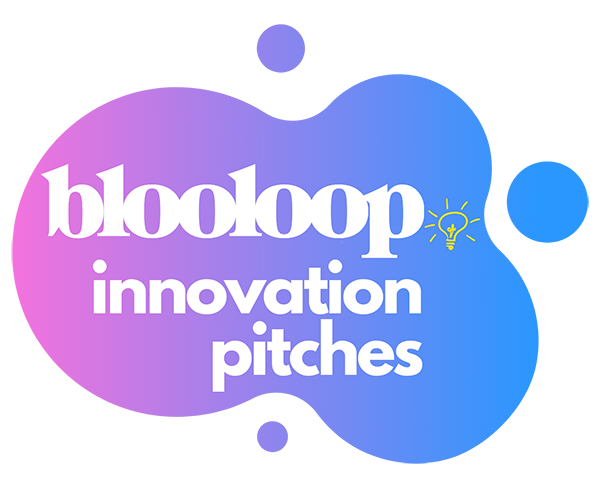
“When we collaborate creatively, part of that is letting go of the reins a little, realising you’re not the master of the idea. We are all going to collaborate, and germinate something bigger and better than the initial concept.”
The application process will open to entrants on 27 May and close midnight 26 June. Companies will be able to submit their pitches directly to Merlin R&D. All companies entering the process will receive feedback. They will also be invited to a live webinar on 6 July. During this, Merlin will explain their view of the future and invite Q&A from the audience. The six most innovative will receive invitations to private online meetings to discuss their ideas further.
If the format is successful, it will be rolled out to explore other types of attractions or elements of the guest experience.
Everyone’s invited to the Merlin R&D party!
Merlin R&D has in the past been a little reticent to come into the spotlight. But that is changing, post-pandemic with a renewed appetite to engage in different ways with a broader creative base.
East says, “I think we tend to keep Merlin Magic Making hidden under a bushel. The big message is that now everybody’s invited to the Merlin party.”







